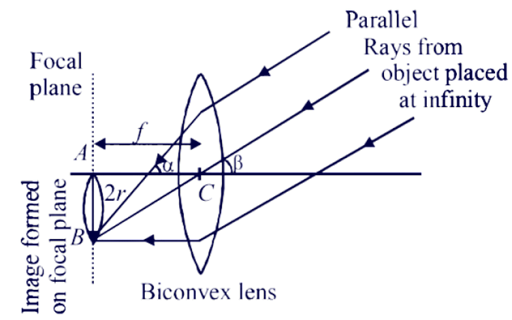
Rays of light from Sun falls on a biconvex lens of focal length f and the circular image of Sun of radius r is formed on the focal plane of the lens. Then
A. Area of image is $πr^2$ and area is directly proportional of f
B. Area of image is $πr^2$ and area is directly proportional of $f^2$
C. Intensity of image increases if f is increased
D. If lower half of the lens is covered with black paper area will become half
Answer
216.3k+ views
Hint: In this question we will use the concept of refraction through biconvex lens and focal plane. The biconvex lens is a straightforward lens made up of two convex surfaces that are spherical in shape and typically have the same radius of curvature.
Formula used:
In a triangle, $\tan \theta =\dfrac{\text{perpendicular}}{\text{base}}$
Complete step by step solution:
Let the focus of the biconvex lens be A, the centre of the biconvex lens be C and the point diametrically opposite to A on the reflection be B. The angle at which sun rays hit the biconvex lens is α and the angle after reflection is β.

In triangle ABC,
$Tan\beta =\dfrac{AB}{AC}=\dfrac{2r}{f}$
$\Rightarrow r=\dfrac{f}{2}\tan \beta $
$\Rightarrow r\propto f$
$\Rightarrow {{r}^{2}}\propto {{f}^{2}}$ - (1)
Area of the image = $πr^2$ and from equation (1), it is directly proportional to $f^2$.
Hence, the correct answer is B.
Additional Information: A biconvex lens is a type of simple lens that consists of two convex surfaces that are spherical in shape and often have the same radius of curvature. They can also be referred to as convex-convex lenses. A collimated or perfectly parallel light beam travels through a biconvex lens and converges to a point or focus that is behind the lens. There will be about two focal points and two centres because the lens is curved on both sides. The principal axis is the line that passes through the centre of a biconvex lens.
Note: After refraction the angle should change and all the rays should converge at the focal point. Sun is taken to be at an infinite distance.
Formula used:
In a triangle, $\tan \theta =\dfrac{\text{perpendicular}}{\text{base}}$
Complete step by step solution:
Let the focus of the biconvex lens be A, the centre of the biconvex lens be C and the point diametrically opposite to A on the reflection be B. The angle at which sun rays hit the biconvex lens is α and the angle after reflection is β.

In triangle ABC,
$Tan\beta =\dfrac{AB}{AC}=\dfrac{2r}{f}$
$\Rightarrow r=\dfrac{f}{2}\tan \beta $
$\Rightarrow r\propto f$
$\Rightarrow {{r}^{2}}\propto {{f}^{2}}$ - (1)
Area of the image = $πr^2$ and from equation (1), it is directly proportional to $f^2$.
Hence, the correct answer is B.
Additional Information: A biconvex lens is a type of simple lens that consists of two convex surfaces that are spherical in shape and often have the same radius of curvature. They can also be referred to as convex-convex lenses. A collimated or perfectly parallel light beam travels through a biconvex lens and converges to a point or focus that is behind the lens. There will be about two focal points and two centres because the lens is curved on both sides. The principal axis is the line that passes through the centre of a biconvex lens.
Note: After refraction the angle should change and all the rays should converge at the focal point. Sun is taken to be at an infinite distance.
Recently Updated Pages
Wheatstone Bridge Explained: Working, Formula & Uses

Young’s Double Slit Experiment Derivation Explained

JEE Atomic Structure and Chemical Bonding important Concepts and Tips

JEE Amino Acids and Peptides Important Concepts and Tips for Exam Preparation

Electricity and Magnetism Explained: Key Concepts & Applications

Chemical Properties of Hydrogen - Important Concepts for JEE Exam Preparation

Trending doubts
JEE Main 2026: Application Form Open, Exam Dates, Syllabus, Eligibility & Question Papers

Derivation of Equation of Trajectory Explained for Students

Hybridisation in Chemistry – Concept, Types & Applications

Understanding the Angle of Deviation in a Prism

Understanding Collisions: Types and Examples for Students

How to Convert a Galvanometer into an Ammeter or Voltmeter

Other Pages
JEE Advanced Marks vs Ranks 2025: Understanding Category-wise Qualifying Marks and Previous Year Cut-offs

Ideal and Non-Ideal Solutions Explained for Class 12 Chemistry

Degree of Dissociation: Meaning, Formula, Calculation & Uses

Understanding Electromagnetic Waves and Their Importance

Understanding the Electric Field of a Uniformly Charged Ring

Understanding Average and RMS Value in Electrical Circuits




